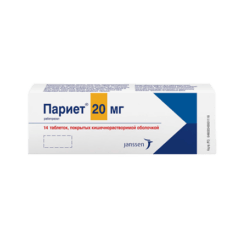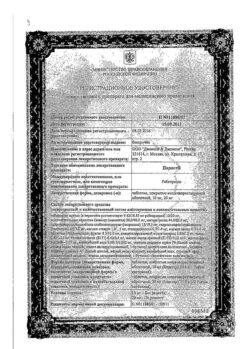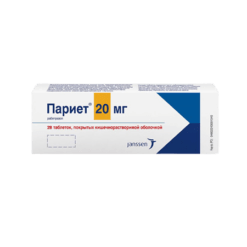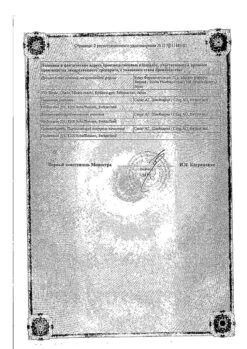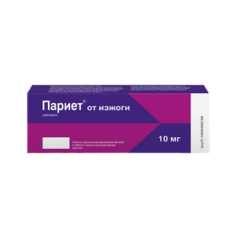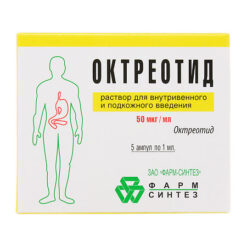No products in the cart.
Pariet, 10 mg 7 pcs.
€1.00
Out of stock
(E-mail when Stock is available)
EAN: 4602243003518
SKU: 225610
Categories: Medicine, Stomach, intestines, liver, Ulcer and gastritis
Description
Pharmacodynamics
A gastric gland secretion reducing agent is a proton pump inhibitor.
The mechanism of action
Rabeprazole sodium belongs to the class of antisecretory agents, benzimidazole derivatives. Rabeprazole sodium inhibits gastric juice secretion by specifically inhibiting the H+/K+ ATPase on the secretory surface of gastric parietal cells. The H+/K+ ATPase is a protein complex that functions as a proton pump, so sodium rabeprazole is a proton pump inhibitor in the stomach and blocks the final stage of acid production. This effect is dose-dependent and results in suppression of both basal and stimulated acid secretion regardless of the stimulus. Rabeprazole sodium has no anticholinergic properties.
Antisecretory effects
After oral administration of 20 mg of rabeprazole sodium, the antisecretory effect develops within one hour. Inhibition of basal and stimulated acid secretion 23 h after the first dose of rabeprazole sodium is 69% and 82%, respectively, and continues up to 48 h. This duration of pharmacodynamic action is much longer than that predicted by T1/2 (approximately one hour). This effect can be explained by the prolonged binding of the drug substance to the H+/K+ ATPase of the gastric parietal cells. The magnitude of the inhibitory effect of rabeprazole sodium on acid secretion reaches a plateau after three days of taking rabeprazole sodium. When discontinued, secretory activity is restored within 1-2 days.
The effect on plasma gastrin levels
In clinical studies, patients were treated with 10 or 20 mg of rabeprazole sodium daily for a treatment duration of up to 43 months. Plasma gastrin levels were elevated for the first 2 to 8 weeks, reflecting an inhibitory effect on acid secretion. Gastrin concentrations returned to baseline levels usually within 1-2 weeks after discontinuation of treatment.
The effect on enterochromaffin-like cells
. In a study of human gastric biopsy specimens from the antrum and gastric fundus of 500 patients treated with rabeprazole sodium or the comparison drug for 8 weeks, no consistent changes were found in the morphological structure of enterochromaffin-like cells, gastritis severity, frequency of atrophic gastritis, intestinal metaplasia or the spread of Helicobacter pylori infection.
In a study involving more than 400 patients receiving rabeprazole sodium (10 mg/day or 20 mg/day) for up to 1 year, the incidence of hyperplasia was low and comparable to that of omeprazole (20 mg/kg). No cases of adenomatous changes or carcinoid tumors observed in rats were reported.
Systemic effects of rabeprazole sodium on the central nervous system, cardiovascular or respiratory systems have not been found at this time. Rabeprazole sodium has been shown to have no effect on thyroid function, carbohydrate metabolism, blood levels of parathyroid hormone, and levels of cortisol, estrogen, testosterone, prolactin, glucagon, follicle stimulating hormone (FSH), luteinizing hormone (LH), renin, aldosterone and somatotropic hormone when taken orally in a dose of 20 mg for 2 weeks.
Pharmacokinetics
Intake
Rabeprazole is rapidly absorbed from the gut, and its peak plasma concentrations are reached approximately 3.5 h after a dose of 20 mg. Changes in peak plasma concentrations (Cmax) and values of area under the curve “concentration-time” (AUC) of rabeprazole are linear in the dose range from 10 to 40 mg. Absolute bioavailability after oral administration of 20 mg (compared with intravenous administration) is about 52%. In addition, bioavailability does not change with repeated administration of rabeprazole. In healthy volunteers, the T1/2 period from plasma is about 1 h (varying from 0.7 to 1.5 h) and the total clearance is 3.8 ml/min/kg.
In patients with chronic liver damage, the AUC is doubled compared to healthy volunteers, indicating decreased first-pass metabolism, and the T1/2 from plasma is increased by 2-3 times. Neither the time of intake of the drug during a day, nor antacids affect absorption of rabeprazole. Taking the drug with fatty food slows down absorption of rabeprazole by 4 hours or more, but neither Cmax nor degree of absorption is changed.
Distribution
In humans the degree of binding of rabeprazole to plasma proteins is about 97%.
Metabolism and excretion
In healthy subjects
After a single oral dose of 20 mg of 14C-labeled rabeprazole sodium, no unchanged drug was found in the urine. About 90% of rabeprazole is excreted in the urine mainly as two metabolites: mercapturic acid conjugate (M5) and carboxylic acid (M6), and also in the form of two unknown metabolites identified in the toxicological analysis. The remainder of the administered rabeprazole sodium is excreted with the feces. Total excretion is 99.8%. These data indicate a small excretion of metabolites of sodium rabeprazole with bile. The main metabolite is thioether (M1). The only active metabolite is desmethyl (M3), but it was observed in low concentration only in one study participant after administration of 80 mg of rabeprazole.
Terminal renal failure
In patients with stable, terminal failure who require maintenance hemodialysis (creatinine clearance < 5ml/min/1.73m2), excretion of rabeprazole sodium is similar to that of healthy volunteers. AUC and Cmax in these patients were approximately 35% lower than in healthy volunteers. On average, the T1/2 of rabeprazole was 0.82 h in healthy volunteers, 0.95 h in patients during hemodialysis and 3.6 h after hemodialysis. Clearance of the drug in patients with kidney disease requiring hemodialysis was approximately twice as high as in healthy volunteers.
Chronic compensated cirrhosis
Patients with chronic compensated cirrhosis tolerate rabeprazole sodium at a dose of 20 mg once daily, although AUC is doubled and Cmax is increased by 50% compared to healthy volunteers of the appropriate sex. Elderly patients The elimination of rabeprazole is slightly delayed in elderly patients. After 7 days of taking rabeprazole at 20 mg per day, AUC was approximately doubled and Cmax was increased by 60% compared with young healthy volunteers. However, no evidence of rabeprazole cumulation was observed.
CYP2C19 polymorphism
In patients with delayed CYP2C19 metabolism after 7 days of taking rabeprazole at a dose of 20 mg daily, AUC increased 1.9-fold and Cmax 1.6-fold compared to the same parameters in “fast metabolizers,” while Cmax increased by 40%.
Indications
Indications
Symptoms of dyspepsia associated with increased acidity of gastric juice, including symptoms of gastroesophageal reflux disease (heartburn, sour belching).
Active ingredient
Active ingredient
Composition
Composition
Active substances:
Rabeprazole sodium 10 mg, which corresponds to the content of rabeprazole 9.42 mg.
Auxiliary substances:
mannitol (mannitol) – 26 mg,
magnesium oxide – 44 mg,
hydroxypropylcellulose slightly substituted (hyprolose) – 13 mg,
/p>
hydroxypropylcellulose (hyprolose) – 4 mg,
magnesium stearate – 1 mg, ethylcellulose – 0.7 mg,
hypromellose phthalate – 8.5 mg,
p> diacetylated monoglyceride – 0.85 mg,
talc – 0.8 mg,
titanium dioxide (E171) – 0.43 mg,
ferrous oxide red (E172) – 0.02 mg,
Carnauba wax – 0.0015 mg,
Food gray ink F6 (shellac white, iron oxide black, dehydrated ethanol, 1-butanol).
How to take, the dosage
How to take, the dosage
Pariet tablets should be swallowed whole without chewing or crushing. It was found that neither time of day nor food intake affect the activity of Rabeprazole sodium.
In acute peptic ulcer and anastomotic ulcer
It is recommended to take orally 10 mg or 20 mg once daily. Usually cure occurs after 6 weeks of therapy, but in some cases the duration of treatment may be extended for an additional 6 weeks.
In case of duodenal ulcer in the acute phase
The drug is recommended to be taken in a dose of 20 mg 1 time per day. In some cases, therapeutic effect occurs when taking the drug in a dose of 10 mg once daily. The duration of treatment is from 2 to 4 weeks. If necessary, the duration of treatment may be increased for 4 more weeks.
In treatment of erosive GERD or reflux esophagitis
It is recommended to take orally 10-20 mg once daily. The duration of treatment is from 4 to 8 weeks. If necessary, the duration of treatment may be increased for 8 more weeks.
In maintenance therapy of GERD
It is recommended to take orally 10-20 mg once a day. The duration of treatment depends on the patient’s condition.
In NERD without esophagitis
It is recommended to take the drug orally 10-20 mg 1 time per day. If after 4 weeks of treatment the symptoms have not disappeared, further evaluation of the patient should be performed. Once symptoms have resolved and to prevent future recurrence, an oral dose of 10 mg 1 time daily should be taken on demand.
For treatment of Zollinger-Elison syndrome and other conditions characterized by pathological hypersecretion
The dose is adjusted individually. The initial dose is 60 mg/day, and then the dose is increased to 100 mg/day in a single dose or 60 mg 2 times/day. For some patients, fractional dosing is preferable. Treatment should be continued as clinically necessary. In some patients with Zollinger-Elison syndrome, the duration of treatment with rabeprazole was up to 1 year.
For eradication of Helicobacter pylori
It is recommended to take orally 20 mg 2 times a day according to a certain scheme with an appropriate combination of antibiotics. The duration of treatment is 7 days.
Patients with renal insufficiency do not require dose adjustment.
In patients with mild to moderate hepatic impairment the concentration of rabeprazole in blood is usually higher than in healthy patients.
Caution should be exercised when prescribing Pariet in patients with severe hepatic impairment.
Dose adjustment is not necessary in elderly patients.
Children
The safety and efficacy of rabeprazole sodium 20 mg for short-term (up to 8 weeks) treatment of GERD in children aged 12 years and older has been confirmed by extrapolation of results of adequate and well-controlled studies confirming the effectiveness of rabeprazole sodium for adults and safety and pharmacokinetics studies for pediatric patients. The recommended dose for children aged 12 years and older is 20 mg once daily for up to 8 weeks. Safety and efficacy of rabeprazole sodium for other indications has not been established for pediatric patients.
The safety and effectiveness of rabeprazole sodium for treatment of GERD in children under 12 years of age has not been established.
Interaction
Interaction
The cytochrome P450 system
Sodium rabeprazole, like other proton pump inhibitors (PPIs), is metabolized with the cytochrome P450 (CYP450) system in the liver. In in vitro studies on human liver microsomes it was shown that rabeprazole sodium is metabolized by CYP2C19 and CYP3A4 isoenzymes. Studies on healthy volunteers showed that rabeprazole sodium has no pharmacokinetic or clinically significant interactions with drugs that are metabolized by the cytochrome P450 system – warfarin, phenytoin, theophylline and diazepam (regardless of whether patients metabolize diazepam heavily or weakly).
There has been a study of combination therapy with antibacterial drugs. This four-way crossover study involved 16 healthy volunteers who received 20 mg of rabeprazole, 1,000 mg of amoxicillin, 500 mg of clarithromycin, or a combination of these three drugs (RAC – rabeprazole, amoxicillin, clarithromycin). AUC and Cmax values for clarithromycin and amoxicillin were similar when comparing combination therapy with monotherapy. The AUC and Cmax values for rabeprazole increased by 11% and 34%, respectively, and the AUC and Cmax for 14-hydroxy-clarytromycin (the active metabolite of clarithromycin) increased by 42% and 46%, respectively, for combination therapy compared with monotherapy. This increase in exposure rates for rabeprazole and clarithromycin was not found to be clinically significant.
Interactions due to inhibition of gastric juice secretion
Rabeprazole sodium has a sustained and prolonged suppression of gastric juice secretion. Thus, there may be an interaction with substances for which absorption is pH-dependent. When concomitant administration with rabeprazole sodium, absorption of ketoconazole is reduced by 30%, and absorption of digoxin is increased by 22%. Consequently, for some patients observation should be carried out to decide whether it is necessary to adjust the dose when concomitant administration of rabeprazole sodium with ketoconazole, digoxin or other drugs for which absorption depends on pH.
Atazanavir
Atazanavir 300 mg/ritonavir 100 mg concomitantly taken with omeprazole (40 mg once daily) or atazanavir 400 mg with lansoprazole (60 mg once daily) in healthy volunteers showed significant reduction in atazanavir exposure. Atazanavir absorption is pH dependent. Although concomitant administration with rabeprazole has not been studied, similar results are expected for other PPIs. Thus, concomitant administration of atazanavir with proton pump inhibitors, including rabeprazole, is not recommended.
Antacids
In clinical studies, antacids have been used in conjunction with rabeprazole sodium. No clinically significant interactions of rabeprazole sodium with aluminum hydroxide gel or with magnesium hydroxide were observed.
In a clinical study during administration of rabeprazole sodium with fat-dense foods no clinically significant interactions were observed. Administration of rabeprazole sodium concomitantly with fat-rich food may delay absorption of rabeprazole up to 4 hours or more, but Cmax and AUC are not changed.
Cyclosporine
In vitro experiments using human liver microsomes showed that rabeprazole inhibited metabolism of cyclosporine with IC50 of 62 μmol, i.e. at the concentration 50 times higher than Cmax for healthy volunteers after 20 days of taking 20 mg of rabeprazole. The degree of inhibition is similar to that of omeprazole for equivalent concentrations.
Methotrexate
According to reports of adverse events, data from published pharmacokinetic studies and data from retrospective analysis, it can be assumed that simultaneous administration of PPI and methotrexate (especially in high doses), can lead to increased concentration of methotrexate and/or its metabolite hydroxytetrexate and increase T1/2. However, no special studies of drug interaction of methotrexate with PPIs have been conducted.
Special Instructions
Special Instructions
Patient response to therapy with rabeprazole sodium does not rule out the presence of malignancy in the stomach.
Pariet tablets should not be chewed or crushed. The tablets should be swallowed whole. It has been found that neither time of day nor food intake affects the activity of Rabeprazole sodium.
In a specific study in patients with mild to moderate hepatic impairment no significant difference in the incidence of side effects of Pariet compared to that in age and sex matched healthy subjects was found, but nevertheless caution is recommended when first prescribing Pariet in patients with severe hepatic impairment. The AUC of rabeprazole sodium in patients with severe hepatic impairment is approximately twice as high as in healthy patients.
Patients with impaired renal or hepatic function do not require dose adjustment of Pariet.
Hypomagnesemia
In treatment with proton pump inhibitors (PPIs) for at least 3 months, cases of symptomatic or asymptomatic hypomagnesemia have rarely been reported. Most of these cases were reported one year after therapy. Serious adverse events were tetany, arrhythmias, and seizures. Most patients required treatment for hypomagnesemia, which included magnesium replacement and withdrawal of proton pump inhibitor therapy. In patients who will receive long-term treatment or who take PPIs with drugs such as digoxin or drugs that can cause hypomagnesemia (e.g., diuretics), health care providers should monitor magnesium concentrations before treatment with proton pump inhibitors and during treatment.
Patients should not take other acid-reducing drugs, such as H2-receptor blockers or PPIs, at the same time as Pariet.
Bone fractures
Observational studies suggest that PPI therapy may increase the risk of osteoporosis-related fractures of the hip, wrist, or spine. The risk of fractures was increased in patients who received high-dose PPIs for a long period of time (one year or more).
The concomitant use of rabeprazole with methotrexate
According to the literature, concomitant use of PPIs with methotrexate (especially in high doses), can lead to increased concentration of methotrexate and/or its metabolite hydroxytetrexate and increase T1/2 period, which may lead to methotrexate toxicity. If high doses of methotrexate are necessary, temporary discontinuation of PPI therapy may be considered.
Clostridium difficile
The PPI therapy may lead to an increased risk of gastrointestinal infections such as Clostridium difficile.
Patients taking Pariet for short-term symptomatic treatment of manifestations of GERD and NERD (e.g., heartburn) without a prescription should see their physician in the following cases:
Contraindications
Contraindications
With caution: use in patients with severe renal impairment.
Side effects
Side effects
Based on the experience of clinical trials, it can be concluded that Pariet is usually well tolerated by patients. Side effects are generally mild to moderate and transient.
In clinical studies: headache, abdominal pain, diarrhea, flatulence, constipation, dry mouth, dizziness, rash, peripheral edema.
Determine the frequency of adverse reactions:
Immune system disorders: rare – acute systemic allergic reactions.
Hematopoietic system: rare – thrombocytopenia, neutropenia, leukopenia.
Metabolism: rarely – hypomagnesemia.
Hepatobiliary system: increased activity of liver enzymes; rarely – hepatitis, hepatic encephalopathy.
Urinary system disorders: very rare – interstitial nephritis.
Skin and subcutaneous tissue disorders: rare – bullous rashes, urticaria, very rare – erythema multiforme, toxic epidermal necrolysis, Stevens-Johnson syndrome.
Muscular system disorders: rare – myalgia, arthralgia.
Reproductive system disorders: very rare – gynecomastia.
There were no changes in other laboratory parameters during rabeprazole administration. According to post-marketing observations, proton pump inhibitors may increase the risk of fractures.
Overdose
Overdose
Symptoms: data on intentional or accidental overdose are minimal. No cases of severe overdose with rabeprazole have been reported.
Treatment: symptomatic and supportive therapy. A specific antidote is unknown. Rabeprazole binds well to plasma proteins, so it is poorly excreted by dialysis.
Pregnancy use
Pregnancy use
There are no data on the safety of rabeprazole during pregnancy.
Reproduction studies in rats and rabbits have shown no evidence of fertility or fetal defects due to rabeprazole; however, in rats, small amounts of the drug penetrate the placental barrier. Pariet should not be used in pregnancy unless the expected benefits to the mother outweigh the possible harm to the fetus.
It is unknown whether rabeprazole is excreted with breast milk. Corresponding studies in breastfeeding women have not been conducted. However, rabeprazole is found in the milk of lactating rats, and therefore Pariet should not be prescribed to nursing women.
Similarities
Similarities
Additional information
| Shelf life | 2 years |
|---|---|
| Conditions of storage | At a temperature not exceeding 25 °C (do not freeze) |
| Manufacturer | Bushu Pharmaceuticals Ltd., Misato Fektori, Japan |
| Medication form | enteric-soluble film-coated tablets |
| Brand | Bushu Pharmaceuticals Ltd., Misato Fektori |
Other forms…
Related products
Buy Pariet, 10 mg 7 pcs. with delivery to USA, UK, Europe and over 120 other countries.


